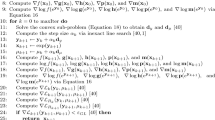Abstract
Automatic design optimization is highly sensitive to problem formulation. The choice of objective function, constraints and design parameters can dramatically impact on the computational cost of optimization and the quality of the resulting design. The best formulation varies from one application to another. A design engineer will usually not know the best formulation in advance. To address this problem, we have developed a system that supports interactive formulation, testing and reformulation of design optimization strategies. Our system includes an executable, data-flow language for representing optimization strategies. The language allows an engineer to define multiple stages of optimization, each using different approximations of the objective and constraints or different abstractions of the design space. We have also developed a set of transformations that reformulate strategies represented in our language. The transformations can approximate objective and constraint functions, abstract or reparameterize search spaces, or divide an optimization process into multiple stages. The system is applicable in principle to any design problem that can be expressed in terms of constrained optimization; however, we expect the system to be most useful when the design artifact is governed by algebraic and ordinary differential equations. We have tested the system on problems of racing yacht design and jet engine nozzle design. We report experimental results demonstrating that our reformulation techniques can significantly improve the performance of automatic design optimization. Our research demonstrates the viability of a reformulation methodology that combines symbolic program transformation with numerical experimentation. It is an important first step in a research program aimed at automating the entire strategy formulation process.
Similar content being viewed by others
References
Peressini A, Sullivan F, Uhl J. The Mathematics of Nonlinear Programming. Springer-Verlag, New York, NY, 1988
Press W, Vetterling W, Teukolsky S, Flannery B. Numerical Recipes. Cambridge University Press, New York, NY, 1986
Lawrence C, Zhou J, Tits A. User's guide for CFSQP version 2.3: A C code for solving (large scale) constrained nonlinear (minimax) optimization problems, generating iterates satisfying all inequality constraints. Technical Report TR-94-16rl, Institute for Systems Research, University of Maryland, August 1995
Kirkpatrick S, Gelatt C, Vecchi M. Optimization by simulated annealing. Science 1983; 220(4598): 45–54
Mitchell M. An Introduction to Genetic Algorithms. MIT Press, Cambridge, MA, 1996
Ellman T, Murata T. Deductive synthesis of numerical simulation programs from networks of algebraic and ordinary differential equations. Automated Software Engineering 1998: 5(3)
Partsch H, Steinbruggen R. Program transformation systems. Computing Surveys 1983; 15(3)
Mostow J. Design by derivational analogy: Issues in the automated replay of design plans. Artificial Intelligence 1989; 40(1–3): 119–184
Letcher J, Marshall J, Oliver J, Salvensen N. Stars and Stripes. Scientific American August 1987; 257(2): 24–32
Ellman T, Keane J, Schwabacher M, Yao K. Multilevel modeling for engineering design optimization. Artificial Intelligence for Engineering Design, Analysis, and Manufacturing 1997; 11(5): 357–378
Gelsey A, Smith D, Schwabacher M, Rasheed K, Miyake K. A search space toolkit. Decision Support Systems, special issue on ‘Unification of Artificial Intelligence with Optimization’ 1996
Shukla V, Gelsey A, Schwabacher M, Smith D, Knight D. Automated design optimization for the p2 and p8 hypersonic inlets. Journal of Aircraft 1997; 34(2)
Keane J. Extensions to Franz, Inc.'s Allegro Common Lisp foreign function interface. Technical Report HPCD-TR-41, Department of Computer Science, Rutgers University, 1996
Char BW, Geddes KO, Gonnet GH, Leong BL, Monagan MB, Watt SM. First Leaves: A Tutorial Introduction to Maple V. Springer-Verlag and Waterloo Maple Publishing, 1992
Gill P, Murray W, Wright M. Practical Optimization. Academic Press, London, 1981
Keane J, Ellman T. Knowledge-based re-engineering of legacy programs for robustness in automated design. Proceedings of the Eleventh Knowledge-Based Software Engineering Conference, Syracuse, NY, 1996, pp 104–113
Orelup MF, Dixon JR, Cohen PR, Simmons MK, Dominic ii: Meta-level control in iterative redesign. Proceedings of the National Conference on Artificial Intelligence, St. Paul, MN, 1988, pp. 25–30
Tong SS. Coupling symbolic manipulation and numerical simulation for complex engineering designs. Intelligent Mathematical Software Systems, North-Holland, New York, NY, 1990, pp. 241–252.
Powell D. Inter-gen: A hybrid approach to engineering design optimization. Technical report, Rensselaer Polytechnic Institute, Department of Computer Science, December 1990
Williams B, Cagan J. Activity analysis: The qualitative analysis of stationary points for optimal reasoning. Proceedings of the Twelfth National Conference on Artificial Intelligence, Seattle, Washington, 1994, pp 1217–1223
Choy J, Agogino A. Symon: Automated symbolic monotonicity analysis system for qualitative design optimization. Proceedings ASME International Computers in Engineering Conference, 1986
Papalambros P, Wilde D. Principles of Optimal Design. Cambridge University Press, New York, NY, 1988
Falkenhainer B, Forbus K. Compositional modeling: Finding the right model for the job. Artificial Intelligence 1991; 51: 95–144
Nayak P. Causal approximations. Artificial Intelligence 1994; 70: 277–334
Abelson H, Eisenberg M, Halfant M, Katzenelson J, Sacks E, Sussman J, Wisdom J, Yip K. Intelligence in scientific computing. Communications of the ACM 32, 1989
Sacks E. Automatic analysis of one parameter planar ordinary differential equations by intelligent numeric simulation. Artificial Intelligence 1991; 48(1): 27–56
Yip K, Zhao F. Spatial aggregation: Theory and applications. Journal of Artificial Intelligence Research 1996; 5, pp 1–26
Rudin W. Principles of Mathematical Analysis. McGraw-Hill, New York, NY, 1964
Author information
Authors and Affiliations
Corresponding author
Rights and permissions
About this article
Cite this article
Ellman, T., Keane, J., Banerjee, A. et al. A transformation system for interactive reformulation of design optimization strategies. Research in Engineering Design 10, 30–61 (1998). https://doi.org/10.1007/BF01580268
Issue Date:
DOI: https://doi.org/10.1007/BF01580268




